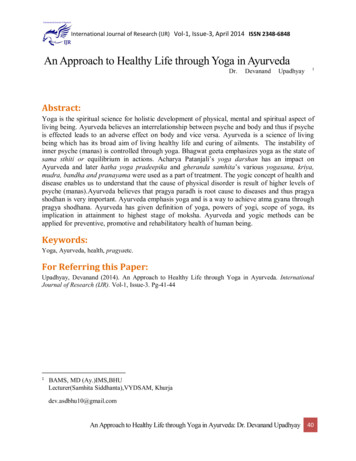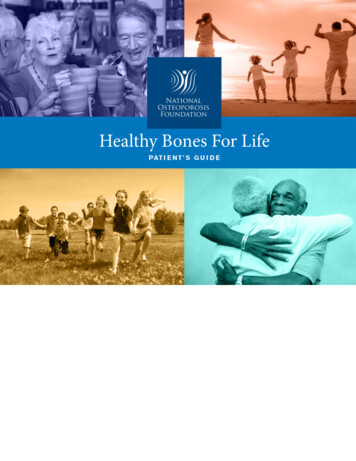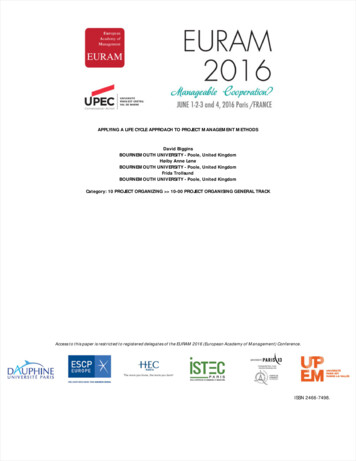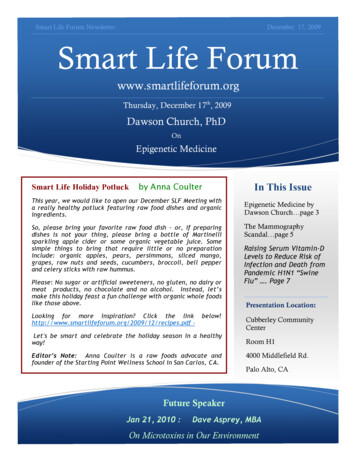
Transcription
International Journal of Research (IJR) Vol-1, Issue-3, April 2014 ISSN 2348-6848An Approach to Healthy Life through Yoga in AyurvedaDr.DevanandUpadhyay1Abstract:Yoga is the spiritual science for holistic development of physical, mental and spiritual aspect ofliving being. Ayurveda believes an interrelationship between psyche and body and thus if psycheis effected leads to an adverse effect on body and vice versa. Ayurveda is a science of livingbeing which has its broad aim of living healthy life and curing of ailments. The instability ofinner psyche (manas) is controlled through yoga. Bhagwat geeta emphasizes yoga as the state ofsama sthiti or equilibrium in actions. Acharya Patanjali’s yoga darshan has an impact onAyurveda and later hatha yoga pradeepika and gheranda samhita’s various yogasana, kriya,mudra, bandha and pranayama were used as a part of treatment. The yogic concept of health anddisease enables us to understand that the cause of physical disorder is result of higher levels ofpsyche (manas).Ayurveda believes that pragya paradh is root cause to diseases and thus pragyashodhan is very important. Ayurveda emphasis yoga and is a way to achieve atma gyana throughpragya shodhana. Ayurveda has given definition of yoga, powers of yogi, scope of yoga, itsimplication in attainment to highest stage of moksha. Ayurveda and yogic methods can beapplied for preventive, promotive and rehabilitatory health of human being.Keywords:Yoga, Ayurveda, health, pragyaetc.For Referring this Paper:Upadhyay, Devanand (2014). An Approach to Healthy Life through Yoga in Ayurveda. InternationalJournal of Research (IJR). Vol-1, Issue-3. Pg-41-441BAMS, MD (Ay.)IMS,BHULecturer(Samhita Siddhanta),VYDSAM, Khurjadev.asdbhu10@gmail.comAn Approach to Healthy Life through Yoga in Ayurveda: Dr. Devanand Upadhyay 40
International Journal of Research (IJR) Vol-1, Issue-3, April 2014 ISSN 2348-6848Introduction:The term yoga can be derived from either oftwo roots, yujir yoga (to yoke) or yujsamādhau (upanishada) meaning to unite, tocombine or to integrate of individual tosupreme. Yoga has also been popularlydefined as "union with the divine" in othercontexts and traditions. According to srimadbhagwat geeta Yoga is defined as“yogah karmasu kaushalam”i.e. yoga isexcellence in performance.“samatvam yogamuchyate” (Bh.geeta 2/47)balanced state in situations like sukhadukha, and other situations.“tam vidyat dukha sanyogaviyogam yogamsangyitam” (Bh.geeta 6/23) detachment ofmiseries is yoga.The members of four divisions of human lifenamelybrahmachari,grihastha,vanaprastha, and sanyasi are all meant to beyogis. Human life is not just for sensegratification. brahmachari under the care ofspiritual master control the mind byabstainingfromsensegratification.Similarly households can perform acts withgreat restraint (Bh.gee.4/26).According to yoga sutra of patanjali yoga isdefined as "the stilling of the changing statesof the mind".3 it has been recommended in 8stages which are yama (restraints), niyama(observances), asana (physical postures),pranayama (breathing control), pratyahara(withdrawl of sense organs), (attainmentofsuperconsciousness).Chronological history of yogic science:Yoga in ancient time was for attainment ofmoksha. Acharya charak has also givenyoga as a way to attain moksha but withtime this has been modified. Pre–philosophical speculations and diverseascetic practices of first millennium BCwere systematized into a formal philosophyin early centuries by the Yoga Sutras ofPatanjali. By the turn of the firstmillennium, hathayoga emergedfrom tantra. Along with its many modernvariations, is the style that many peopleassociate with the word yoga today. Gurusfrom India later introduced yoga to thewest, followingthesuccessofSwami Vivekananda in the late 19th andearly 20th century. In the 1980s, yogabecame popular as a system of physicalexercise across the Western world. Thisform of yoga is often called Hatha yoga.Many studies have tried to determine theeffectiveness of yoga as a complementaryintervention for cancer, schizophrenia,asthma, and heart disease.7,8 Now a daysyoga is more popular as health promoter,prevention from diseases loke diabetesmellitus, hypertension, bronchial asthma ,obesity, stress condition of life.Ayurvedic view towards yoga: “Sukharthasarva bhutanam matah sarva tayah” (ch.su.28/35)Action of every human being is to attainsukha but it depends on knowedge one has.One who follows path after properknowledge is on verge to attain sukha whileother attain dukha .It has been said by acharya charaka thatsites of vedana are manas (psyche), deha(body) and indriyas (senses). Yoga andmoksha are considered to be two stageswhere there is complete eradication from allvedana. Moksha is said to be stage wherethere is complete eradication from vedanaand yoga has been considered as a tool toachieve moksha. Stage of perception ofAn Approach to Healthy Life through Yoga in Ayurveda: Dr. Devanand Upadhyay 41
International Journal of Research (IJR) Vol-1, Issue-3, April 2014 ISSN 2348-6848sukha or dukha is attained from sannikarsh(union) of atma, manas,indriya andindriyartha as this union leads to any sort ofknowledge and it is either perceived assukha or dukha. Sukha is stage of anukulavedana (perception of good) that is achievedrunning on path of dharma while dukha isvice versa. When manas is said to be stilland stable in self then due to non-attachmentwith any karya, it is free from feeling ofsukha and dukha, and with sharira.Process : Describing the process of atmagyana it has been established thatIst stepIndriyas should control fromartha (objects).ndII stepManas should be controlled ormobility of manas should becontrolled.IIIrd step- Manas should attach introvertwith Atman and it shouldrealize gyana of Atman.Ways to achieve:1. Sadavritta (describes maximumyama and niyama) leading to indriyajaya.ch.su.2. achara rasayana (various conductshaving effect like rasayana orrejuvenator. Ch.ch.1/43. controllingofkayika(stealingobjects, coitus with females of others,violence),vachika(rough and rudelanguage, abuse, untimely talk,complaining about others), manasikadharaniyavega(anger,greed,ignorance, shameless, ego, lust,envy)etc. Ch.su.7/28,29,304. follow paths described for mokshamarga leading to suddha manas andsatya buddhi.ch.sh.1,5Comparison of pure manas: On followingthe methods given in moksha marga onegets free from rajas and tamas and purifiedmanas looks similar to a mirror cleaned withoil and cloth or broom. It has been comparedwith sun which shines gracefully in absenceof eclipse, cloud, storm, fog etc. the manasbecomes still in self and it is glorified asdeep inside a lantern.ch.sh.5/18Qualities of satya buddhi: After attainingsuddha manas a person attains suddhabuddhi which is so powerful to break wallsof moha or tamas. Human knows all thebhavas of production and becomesnihaspriha. After attaining satya buddhiyoga siddhi and tattva gyana occurs. Thissatya buddhi is vidya,siddhi, mati, medha,pragya, gyana. Ch. Sh. 5/19. It has beentermed as sthita pra gya in geeta.Powers of yogi: yogis attains 8 siddhiwhich are aavesh(can enter into body ofothers), chetas gyana(knows whats going inothers mind), arthanam chhandatahkriya(can understand indriyartha throughmanas), drishti(can see which is notperceivable from eyes), shrotra(can heat nonperceivable from ear), smriti (memory),kanti(lusture), ishta darshna( can disappearand appear acordng to will).ch.sh.1/141Yoga and health:Acording to swami kuvalayananda founderof kaivalya dhama, positive health does notmean freedom from disease but it is jubilantand energetic view of living and feeling thatis peak lstate of living being at all levels –physical, mental, emotional, spiritual, andsocial. Ayurveda can be studied by all forthe attainment of virtues, wealth andpleasure.4 Virtues are attained by treatingindividuals who have spiritual knowledge,who practice and propagate righteousnessand other like mother, father, brother, friendand superiors. These are also achieved bymeditation, propagation and practice of thespiritual knowledge contained in the scienceof life. This has been called as para dharmai.e. best among all codes of right path. AllAn Approach to Healthy Life through Yoga in Ayurveda: Dr. Devanand Upadhyay 42
International Journal of Research (IJR) Vol-1, Issue-3, April 2014 ISSN 2348-6848these constitute the higher virtue of his life.The person endowed with psychic strengthand sattvika character tolerates all by hisown will power. Due to unregulated manasthe action or performance of human runs onwrong way which produces diseases. Due tolack of smriti a human does not rememberwhat is favourable or what is unfavourablefor him. Due to abnormal state of dhi, dhritiand smriti human become unable to controlthe three types of voluntary actions likekayika, vacika manasika. pragyaparadh isthe root cause of diseases, this pragyaparadhcan be prevented through yoga. Atma baladeveloped as result of yoga has supercapability to provide a clear concept ofdecisive actions. Adhyatma gyana is theonly way of pragya shodhan so health canbe maintained through yoga.Discussion:In early century yoga was considered asspiritual disciple practiced for moksha butwith time it is now practiced as analternative and contemporary medicine allaround the world.it has built psychicstability in form of patience, positiveattitude towards life, fitness in body,increasedvitalcapacity.Yogaisphysical, mental, and spiritual practices ordisciplines which originated in ancientIndia with a view to attain a state ofpermanent peace of mind in order toexperience one's true self. Early Charak hasproposed sadavritaa which are code ofconducts, achara rasayana, dharaniyamanasika vega like desire, anger, greed,hatred, mosha marga etc. following theseleads to conquer over senses and manas.Ones sattva is increased leading todiminutionofrajasandtamas(psychological ailments) leads to stablepragya or intellect. This stable intellect notonly thinks positively but also lead topersonality improvement. Thus yoga ispractical way to attain well-being and isadvised to be practiced for good quality oflife. Presently we are living a life full ofstress. This stress brings disturbances inphysical and psychic dosha s leading todiseases. The attitude to positive thinkingcomes from yoga. Yoga is free of cost, issafe and medication free. So it can bepracticed by all leading to knowledge, purityof mind and intellect and healthy livingbeing.Conclusion:Ayurveda has described yoga in plenty andvarious conducts to lead to yoga which leadsto highest goal of salvation.Abbreviations used: ch.sh. Charaka sharirasthana, ch.su. charaka sutra sthanaAn Approach to Healthy Life through Yoga in Ayurveda: Dr. Devanand Upadhyay 43
International Journal of Research (IJR) Vol-1, Issue-3, April 2014 ISSN 2348-6848References:1. Dasgupta, Surendranath (1975). A History of Indian Philosophy 1. Delhi, India: MotilalBanarsidass. p. 226. ISBN 81-208-0412-0.2. Srimad Bhagwat Geeta By A.C Bhakhtivedant Swamy, Bhativedant Book TrustPublication, Mumbai 20063. Sahu divya, Singh Rani, Optimism through yoga; Annual proceedings of recentadvances in yoga, p.36, ISBN 978-81-925546-0-0.4. Murthy KHHVSS Narsimha, Kumar Dileep: Non pharmacological approach inmanagement of manas rogas through yoga and Ayurveda, pg.25 Annual proceedings ofRecent advances in yoga, p.36, ISBN 978-81-925546-0-0.5. Charak samhita with Vidyotini Hindi Commentary, Vol-I and II, shastri K.N. andChaturvedi, G.N. (Ed. Shastri R.D. et al) Chaukhambha. Bharati Academy Varanasi1984.6. Sushruta Samhita of Maharsi Sushruta with Ayurvedatatwasandipika, HindiCommentary, Shastri, a.d., Chaukhambha Sanskrit Sansthan, Varanasi, 1953-1959.7. Smith, Kelly B.; Caroline F. Pukall (May 2009). "An evidence-based review of yoga asa complementary intervention for patients with cancer". Psycho-Oncology 18(5):465–475. doi:10.1002/pon.1411.PMID 18821529.8. Vancampfort, D.; Vansteeland, K.; Scheewe, T.; Probst, M.; Knapen, J.; De Herdt, A.;De Hert, M. (July 2012). "Yoga in schizophrenia: a systematic review of randomisedcontrolled trials". Acta Psychiatrica Scandinavica 126 (1): 12–20., art.nr.10.1111/j.1600-0447.2012.01865.x9. Sharma, Manoj; Taj Haider (Oct 2012). "Yoga as an Alternative and ComplementaryTreatment for Asthma: A Systematic Review". Journal of Evidence-BasedComplementary&AlternativeMedicine 17 (3):212–217.doi:10.1177/2156587212453727.10. Innes, Kim E.; Cheryl Bourguignon (November–December 2005). "Risk IndicesAssociated with the Insulin Resistance Syndrome, Cardiovascular Disease, and PossibleProtection with Yoga: A Systematic Review". Journal of the American Board ofFamily Medicine 18 (6): 491–519.An Approach to Healthy Life through Yoga in Ayurveda: Dr. Devanand Upadhyay 44
“yogah karmasu kaushalam”i.e. yoga is excellence in performance. “samatvam yogamuchyate” (Bh.geeta 2/47) balanced state in situations like sukha dukha, and other situations. “tam vidyat dukha sanyogaviyogam yogam sangyitam” (Bh.geeta 6/23) detachment of miseries is yoga. The members of four divisions of human life











